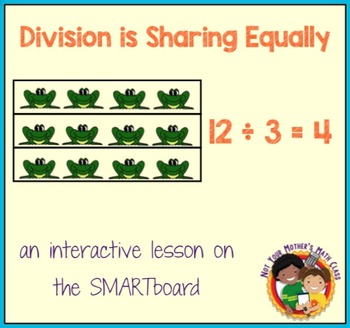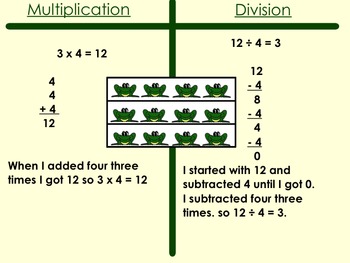Division is Sharing Equally
Not Your Mother's Math Class
2.9k Followers
Grade Levels
3rd - 4th, Homeschool
Subjects
Resource Type
Standards
CCSS3.OA.A.2
CCSS3.OA.A.4
CCSS3.OA.B.6
Formats Included
- NOTEBOOK (SMARTboard) File
Pages
18 pages
Not Your Mother's Math Class
2.9k Followers
Description
Division is Sharing Equally - an Interactive Lesson on the SMARTboard
Lesson Objectives
• The students will use manipulatives to solve division word problems.
• The students will identify the relationship between multiplication and division.
~~~~~~~~~~~~~~~~~~~~~~~~~~~~~~~~~~~~~~~~~~~~~~~~~~~
This SMARTboard lesson is divided into 3 sections:
• Teacher Input: This section introduces the concept of division as it relates to multiplication, addition and subtraction.
• Guided Practice: This section is scaffolded to remove some support prior to independent practice. It begins with 3 problems for students to move pictures on the SMARTboard to show division situations. Then there are 2 more problems for students to solve but they have to count out the number of objects they need.
• Independent Practice: There is an attached PDF file for student practice. Slides of each problem are also included so you can have students check their papers together.
~~~~~~~~~~~~~~~~~~~~~~~~~~~~~~~~~~~~~~~~~~~~~~~~~~~
Please look at the preview to see individual slides. Interactive components may not be visible in the preview.
~~~~~~~~~~~~~~~~~~~~~~~~~~~~~~~~~~~~~~~~~~~~~~~~~~~
Standards
This resource can be used with Common Core Standards 3.OA.A.2, 3.OA.A.4 and 3.OA.B6 as well as various state standards. Daisy Fryer at Not Your Mother’s Math Class is the sole creator of this product and does not claim endorsement or association with the creators of the CCSS standards.
~~~~~~~~~~~~~~~~~~~~~~~~~~~~~~~~~~~~~~~~~~~~~~~~~~~~
Click here for more SMARTboard products.
Click
Lesson Objectives
• The students will use manipulatives to solve division word problems.
• The students will identify the relationship between multiplication and division.
~~~~~~~~~~~~~~~~~~~~~~~~~~~~~~~~~~~~~~~~~~~~~~~~~~~
This SMARTboard lesson is divided into 3 sections:
• Teacher Input: This section introduces the concept of division as it relates to multiplication, addition and subtraction.
• Guided Practice: This section is scaffolded to remove some support prior to independent practice. It begins with 3 problems for students to move pictures on the SMARTboard to show division situations. Then there are 2 more problems for students to solve but they have to count out the number of objects they need.
• Independent Practice: There is an attached PDF file for student practice. Slides of each problem are also included so you can have students check their papers together.
~~~~~~~~~~~~~~~~~~~~~~~~~~~~~~~~~~~~~~~~~~~~~~~~~~~
Please look at the preview to see individual slides. Interactive components may not be visible in the preview.
~~~~~~~~~~~~~~~~~~~~~~~~~~~~~~~~~~~~~~~~~~~~~~~~~~~
Standards
This resource can be used with Common Core Standards 3.OA.A.2, 3.OA.A.4 and 3.OA.B6 as well as various state standards. Daisy Fryer at Not Your Mother’s Math Class is the sole creator of this product and does not claim endorsement or association with the creators of the CCSS standards.
~~~~~~~~~~~~~~~~~~~~~~~~~~~~~~~~~~~~~~~~~~~~~~~~~~~~
Click here for more SMARTboard products.
Click
Total Pages
18 pages
Answer Key
N/A
Teaching Duration
N/A
Report this resource to TPT
Reported resources will be reviewed by our team. Report this resource to let us know if this resource violates TPT’s content guidelines.
Standards
to see state-specific standards (only available in the US).
CCSS3.OA.A.2
Interpret whole-number quotients of whole numbers, e.g., interpret 56 ÷ 8 as the number of objects in each share when 56 objects are partitioned equally into 8 shares, or as a number of shares when 56 objects are partitioned into equal shares of 8 objects each. For example, describe a context in which a number of shares or a number of groups can be expressed as 56 ÷ 8.
CCSS3.OA.A.4
Determine the unknown whole number in a multiplication or division equation relating three whole numbers. For example, determine the unknown number that makes the equation true in each of the equations 8 × ? = 48, 5 = __ ÷ 3, 6 × 6 = ?.
CCSS3.OA.B.6
Understand division as an unknown-factor problem. For example, find 32 ÷ 8 by finding the number that makes 32 when multiplied by 8.





